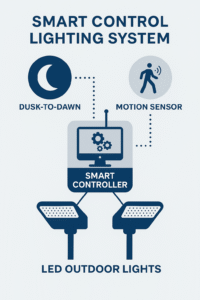10V = 100% Brightness
Lamps run at full output when the controller provides a 10 V signal.
The 0-10V analog dimming system offers a simple yet highly effective way to manage outdoor and industrial lighting. By transmitting a low-voltage control signal, it ensures smooth, flicker-free dimming, making it ideal for projects that require group dimming, stable performance, and easy installation. Proven in road, tunnel, and warehouse applications, it delivers both energy efficiency and long-term reliability.


The 0–10 V control signal is a low-voltage DC reference that tells the LED driver what brightness to deliver. By varying the signal from 0 V to 10 V, the driver outputs a proportional current to the LEDs, enabling smooth, flicker-free dimming with a simple and robust topology that is easy to install and maintain.
Lamps run at full output when the controller provides a 10 V signal.
At 0–1 V, fixtures switch off or hold the lowest dim level (driver dependent).
Voltage and light output change proportionally for predictable control.
Drivers interpret the DC signal to deliver stable, low-noise brightness transitions.
A complete 0-10V dimming solution is made up of three essential parts: the controller, the control cable, and the LED driver with 0-10V interface. Each component plays a specific role to ensure reliable communication and stable dimming performance.
1.Controller
Acts as the “brain” of the system, generating the 0-10V signal.
Can be a simple manual dimmer knob or an advanced smart controller with sensors, timers, or remote control options.
2.Control Cable
A low-voltage pair (e.g., 2×0.75mm²) dedicated to transmitting the dimming signal.
Must be separated from the AC power line to avoid interference.
3.0-10V Compatible LED Driver
Each luminaire’s driver interprets the incoming voltage signal (DIM+ / DIM-).
Adjusts the output current to LEDs accordingly, achieving smooth dimming without flicker.
Two wiring topologies are commonly seen in 0–10 V dimming. Parallel is recommended for modern projects due to higher reliability, while Series (daisy-chain) is legacy and prone to single-point failures.
The controller’s 0–10 V pair is distributed to every luminaire in parallel (DIM+ / DIM-).
Use a dedicated low-voltage cable and keep it separated from AC mains to minimize interference.
The signal loops in and out of each luminaire sequentially.
If a daisy-chain must be used in an existing site, test continuity per segment and keep runs short.
0–10 V analog dimming is widely adopted for outdoor and industrial projects. Understanding both strengths and limitations helps owners and engineers choose the right control strategy for each application.
Easy to understand, wire, and commission for roads, tunnels, and high bays.
Predictable 0–100% control with flicker-free performance from 1–9 V range.
Interoperable across vendors following IEC 60929 Annex E compliant drivers and controls.
Lower system and commissioning cost versus digital protocols for group dimming.
One-way control: the system cannot report fixture status or faults to the controller.
All luminaires on the same line follow the same signal unless wired separately.
Low-voltage signal may be affected if routed parallel to AC mains—keep cables separated.
Long runs can degrade the control signal, causing inconsistent brightness at endpoints.
Tip: For projects requiring single-lamp control and live diagnostics, consider a digital protocol (e.g., DALI) or add local sensors with zone wiring.
0–10 V dimming is versatile and widely used across outdoor and industrial projects. It offers reliable, energy-saving solutions for environments where group dimming and smooth brightness transitions are required.
1.Dimming schedules reduce brightness after midnight to save energy. 2.Ideal for municipal road networks and highways.
1.Adaptive lighting levels based on ambient daylight at tunnel entrances. 2.Ensures driver safety with smooth transitions across zones.
1.Occupancy-based dimming in low-traffic areas. 2.Maximizes energy efficiency in large indoor spaces.
1.Scene-based dimming for parks, campuses, and public plazas. 2.Creates comfortable environments with reduced power consumption.
0–10 V dimming remains one of the most trusted and cost-efficient lighting control methods worldwide. It delivers smooth brightness adjustment, broad compatibility, and proven reliability in roadways, tunnels, warehouses, and landscapes. For project owners and engineers seeking a balance of simplicity, performance, and affordability, 0–10 V is a dependable choice.
Reduce energy costs with scheduled or sensor-based dimming.
Extend product lifetime through optimized light output.
Ensure safety & comfort with flicker-free transitions.
Seamless integration with most mainstream LED drivers.
Our catalog offers modular, energy-saving, and high-performance LED solutions. Share your project needs, and we’ll create a tailored lighting plan for you.



For more professional knowledge and practical guidance, visit our blog to discover in-depth articles on LED street lights and project solutions.
What Is Timer-Based Dimmi
Outdoor Lighting Installa
Introduction – Why Upgrad

Introduction As cities an

Introduction Outdoor ligh
How to Waterproof LED Lig